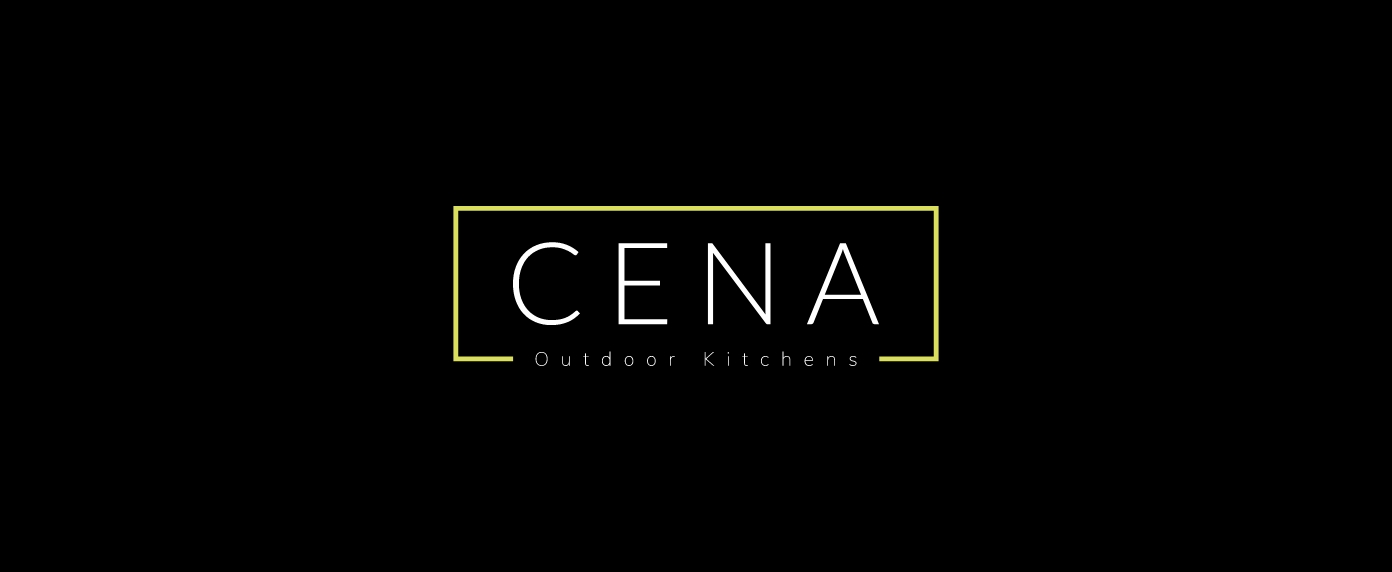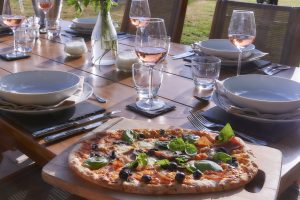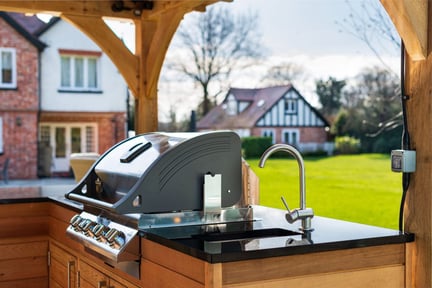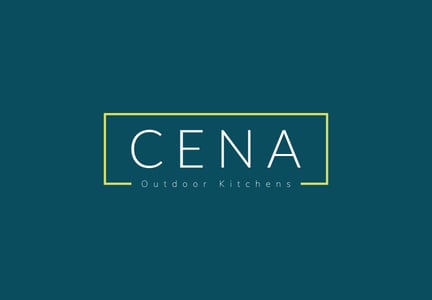Part 1: The Cooking Medium
Just like cooking in an indoor kitchen, outdoor kitchens can cater for every taste possible - whether you prefer to roast a joint of meat or whip up a grilled halloumi salad, the fixtures and fittings of an outdoor kitchen give you the flexibility to do it all. If you’re not sure what your ideal outdoor kitchen looks like, then it’s worth taking a look at the pros and cons of different cooking mediums… let’s answer this burning question if you’ll excuse the pun!
Gas
Modern gas grills provide an incredible array of options and significant benefits for the chef, such as instant heat, zero preparation and no residue to deal when you have finished cooking. You can choose from thermal sensors to help you perfect that steak or ensure a safe chicken wing, timers to follow a recipe to the letter, infrared back burners for more sear control and speed, motorised spits, multi-zone cooking surfaces and smoking boxes.
There is a perception that you cannot create the same flavour with gas as you can with charcoal but others are quick to point out that some gas grills have briquettes that are designed do exactly that job, and smoke boxes add to the depth of flavour.
Once you have introduced a gas feed there are other components that you can add, for example a side burner. This will provide the option to cook using pots and pans as though you have a hob, enabling even less reliance on the indoor kitchen and increasing the enjoyment of cooking outdoors.
Charcoal
Charcoal may require more preparation than gas, but instant light bags remove some of the hassle. Using charcoal also means there is some waiting time to factor in for the coals to turn white, and the hope that you have sufficiently fed the fire to keep it going for longer multi-stage dishes.
A charcoal grill used by a skilled chef can enable some temperature control, with zoned cooking areas for direct and indirect heat, and modern temperature meat sensors (with some even connecting to smart devices for the ultimate "remote" control). A good quality charcoal will burn more evenly, predictably and last longer to assist with more complex menus.
The drama and ambience created with a charcoal grill can be wonderful but will require more preparation and mastery (or practice). There is plenty of advice on techniques, recipes and tools to assist you, and it can be very rewarding when successfully executed.
Electricity
Many people in the UK and Europe have not come across electric grills for outdoor cooking but if you ask any Australian (world experts on the BBQ front!) who has used one of the public park grills seen over there, they will sing their praises. There is definitely something to be said for a Teppan-style hotplate not least that they are so easy to clean – our friends down under event clean them with beer (that's not a typo), so no fiddling with scrubbers and wire racks.
Electric grill plates mean you can use a frying pan, cook sausages without the casualties and even flaky fish or smaller crustaceans and fiddly vegetables become less of a challenge. The versatility and convenience of a hotplate is pretty astounding and something we will certainly see more of in the UK in the future.
A pizza oven
Pizza ovens have enjoyed something of a boom in the last few years and it is easy to understand why. A pizza oven means you can cook family-friendly food together in minutes (after the preparation) to restaurant standards.
The procurement and preparation of seasoned timber does require some planning and administration, and of course you have the same lighting, temperature and timing factors to consider that you have with a charcoal grill. The indirect heat of a pizza oven does remove some of the risk of blackening you will get when cooking on a charcoal grill prematurely.
It’s worth mentioning that a pizza oven is not just for pizza: meat and fish (carefully wrapped in tinfoil) will be full of flavour with a nice charred finish.
So, which cooking medium should you choose? The questions you should consider when making your choice are:
- How important is convenience? Electricity or gas are the most convenient mediums with the widest array of features and controls. Even a less confident cook can tackle a wider variety of recipes with less risk (excluding that from undercooked chicken).
- What dishes are you likely to cook? With some experience and/or some gadgets charcoal can provide an incredible level of flexibility, allowing you to cook anything from a pineapple upside down cake to a family Christmas dinner! Without experience you will get some misfires though and be prepared to dash for the sausages should the challenge get the better of you. Go for the gas/electric options if culinary variety needs to be coupled with convenience or inexperience. If you are going to maintain the tradition of an English summer BBQ then charcoal is a wonderful medium and the atmosphere, smell and flavour are hard to recreate with other options and with experience and practice there is a huge amount you can achieve.
- How experienced are you? The convenience of electricity and gas are hard to beat, if you are less confident as the level of control, flexibility and certainty these provide can allow you to enjoy the experience without getting bogged down in the administration or involvement of charcoal. If you keep it simple, then charcoal offers plenty of variety but be prepared to make the odd mistake and have back-up plans if you want to get out of your comfort zone.
- What does your space and budget look like? These factors may dictate which cooking medium suits your project best. The CENA team are ideally placed to help you work out what will be the best fit for your outdoor kitchen.
- Are you going for ‘Wow Factor’? This is an interesting question; you can wow your guests with a simple, yet perfectly executed dish, or you can go for the drama of a recipe far from the norm. There is a natural drama cooking over glowing embers that is hard to replace, but a spit roast leg of lamb is simpler to perfect with a gas rotisserie complete with infrared burner, timer and sensors.
With traditional onsite-built outdoor kitchens, it is import to future-proof your kitchen as it will be harder to modify once it has been installed. For this reason, it may be better to incorporate more elements at the start. If you decide on a modular style kitchen, such as our slate and cedar model, you have the ability to continually add components and features and you can always revisit the design when you have had a summertime of use to practice and consider. For more advice or to discuss your options, please contact the design team at CENA Outdoor Kitchens.



